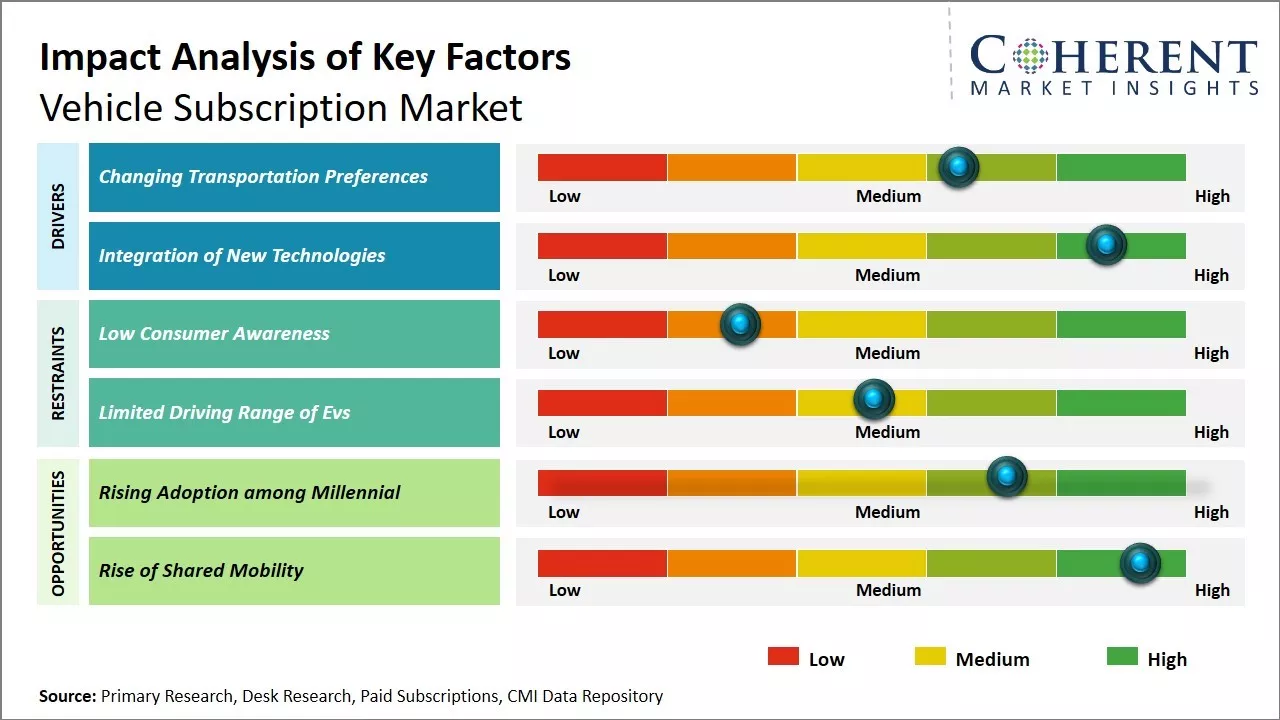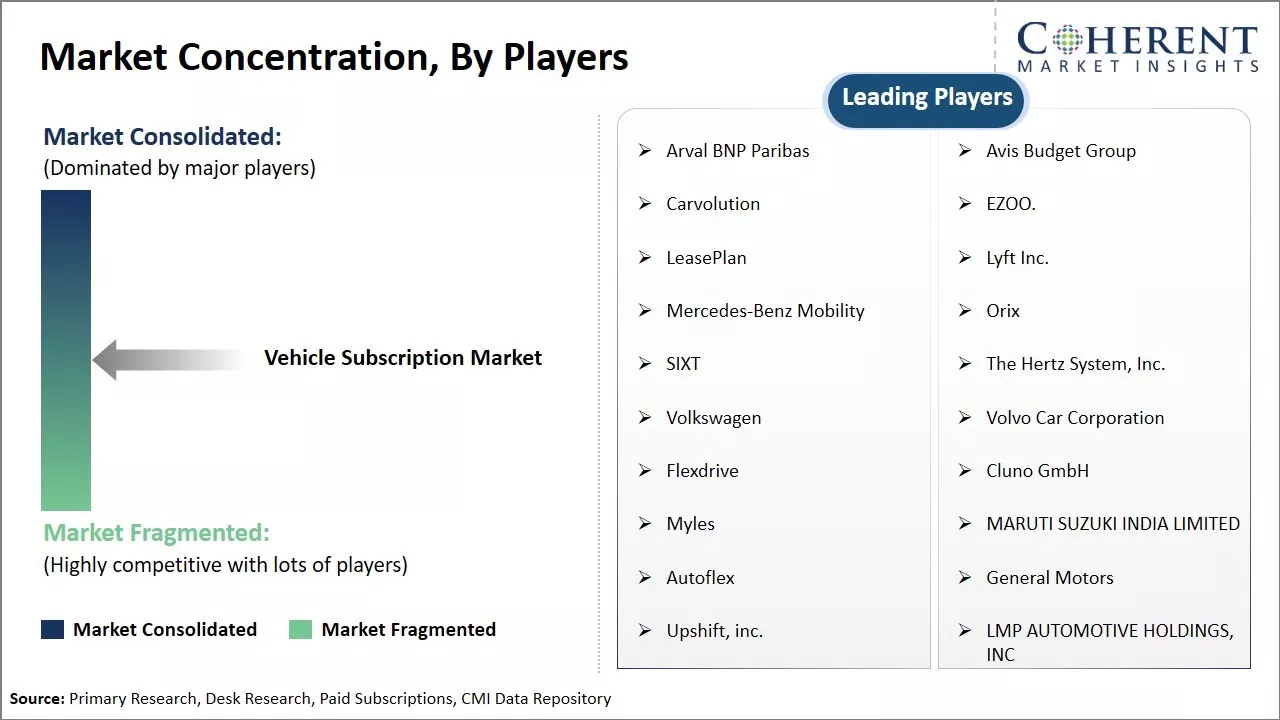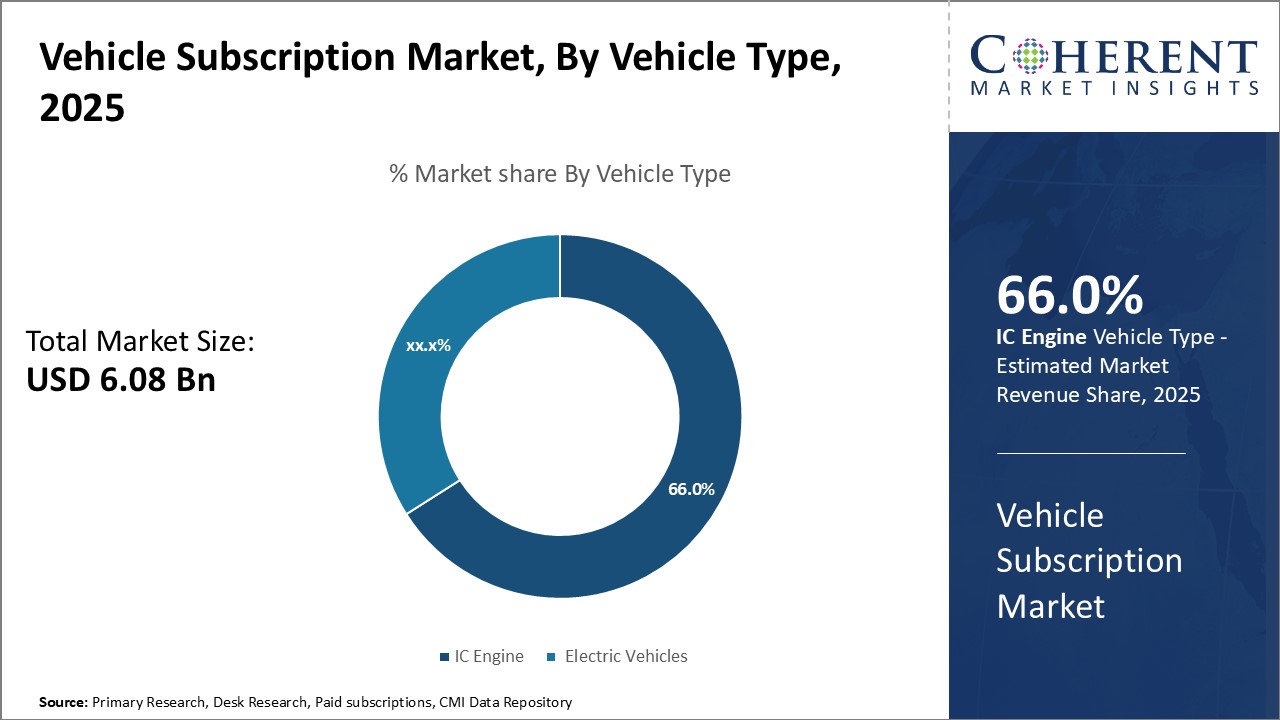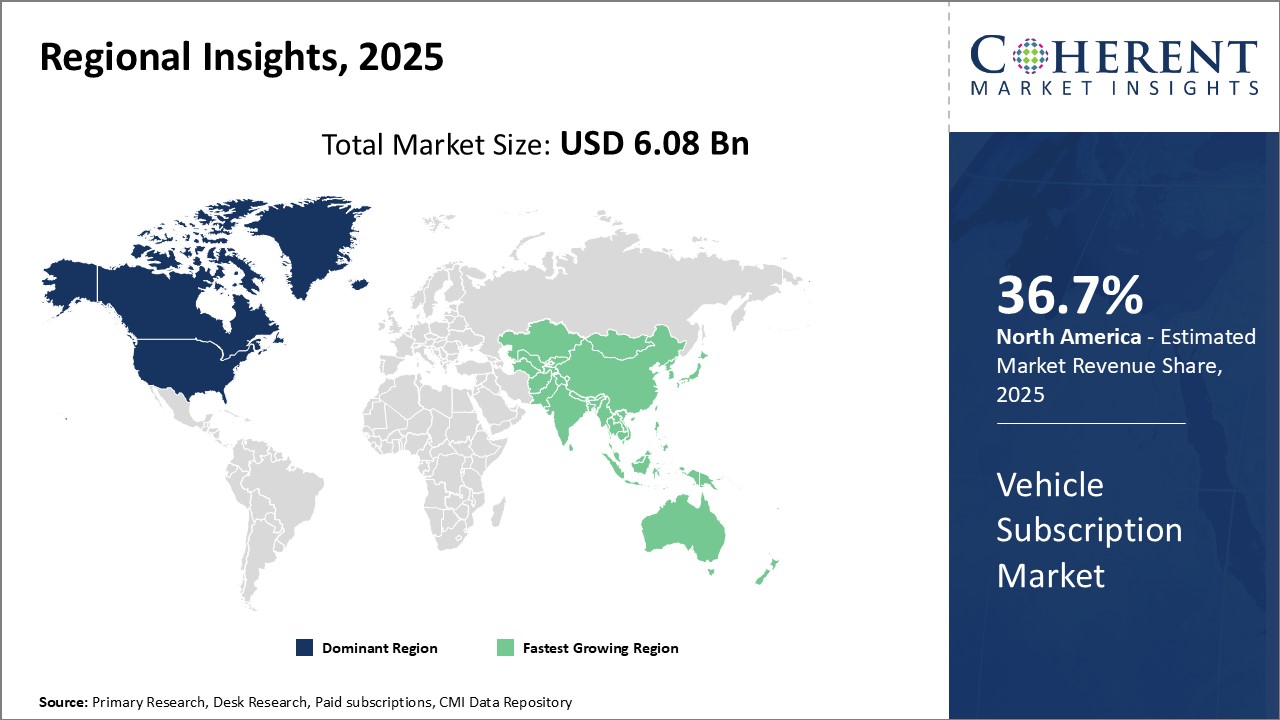Vehicle Subscription Market Size and Trends
The vehicle subscription market is estimated to be valued at USD 6.08 Bn in 2025 and is expected to reach USD 48.15 Bn by 2032, growing at a compound annual growth rate (CAGR) of 34.4% from 2025 to 2032.

Discover market dynamics shaping the industry: Download Free Sample
The vehicle subscription market is expected to witness significant growth over the next few years. The rising preference of consumers towards flexible all-inclusive plans and limiting large up-front costs associated with vehicle ownership are expected to drive the demand for vehicle subscriptions. Additionally, improving vehicle connectivity and frequent technology upgrades available in vehicle subscriptions are appealing to many consumers. As internet and technology penetration increases globally, newer regions are expected to adopt vehicle subscriptions, thus pushing market revenues higher between 2025 and 2032.
Changing Transportation Preferences
The automotive industry is undergoing significant transformation led by evolving customer preferences towards transportation. Younger customers in particular are less inclined to own a vehicle and deal with responsibilities of maintenance, insurance, and other recurring costs. With rising urbanization and focus on sustainability, many prefer the convenience and flexibility of accessing vehicles on demand. Vehicle subscriptions services directly address these changing needs by providing users alternative access to cars and related risks without long term commitments. The subscriptions allow customers to drive multiple makes and models based on their shifting needs and lifestyles. Users can easily upgrade, downgrade or cancel the memberships as per their requirements. The subscriptions also bundle insurance, maintenance and other costs into monthly or annual fee structures, taking away hassles of vehicle ownership. For some customers, the subscriptions even make financial sense as it may be cheaper than owning a vehicle after accounting for taxes, fees and other expenses over longer periods. Others value the freedom these services provide from responsibilities of asset possession. The subscriptions perfectly align with customers seeking short term access versus ownership as their transportation preference evolves with life stages. They are especially appealing to new drivers, millennial and Gen Z who care more about experiences than owning assets. Further, the ubiquitous availability, affordability and convenience factor has seen rapid adoption of subscriptions services in many cities worldwide, reflecting changing consumer attitudes towards personal mobility.
Market Concentration and Competitive Landscape

Get actionable strategies to beat competition: Download Free Sample
Integration of New TechnologiesThe vehicle subscription space is on an incredible growth trajectory fuelled by the rapid integration of new technologies. Advancements in connectivity, electrification, autonomous driving, and analytics are seamlessly coming together to reshape the mobility landscape. Customers are increasingly demanding digital on-demand services with just a few taps on a smartphone. Subscription services are well placed to capitalize on these shifts by offering customers latest vehicles with sophisticated in-car infotainment systems, advanced driver assistance systems and soon even self-driving capabilities. Further, the ability to swap vehicles - upgrade and downgrade - allows customers to experience new innovations through the subscriptions on a continuous basis. Underlying technology platforms also allow aggregating big data for deeper customer insights, enabling personalized on-road experiences and services. Automakers are leveraging these insights to roll out over-the-air software updates, monitor vehicle health in real-time, and roll out new mobility features at scale through the subscription fleets. The services further compliment evolving mobility models such as MaaS and ride-hailing. Above all, advanced electrification will significantly extend vehicle life.
For instance, in February 2021, Hyundai, an automaker, expanded into the European MaaS market with the introduction of our Mocean Subscription service. Mocean Subscription is Hyundai’s global Mobility-as-a-Service (MaaS) brand. With no sign-up fee and a fully digital user experience, customers can enjoy a streamlined registration process from the first click to the handover of their car.

To learn more about this report, Download Free Sample
Market Challenges: Low Consumer AwarenessThe vehicle subscription market currently faces several challenges. Consumer awareness of this alternative to traditional ownership remains relatively low. Subscription services also have relatively high operating costs as they work to grow their fleets while maintaining quality vehicles. Additionally, subscriptions compete with the convenience of owning a vehicle outright. However, gaining scale will help lower costs over time.
Market Opportunities: Rising Adoption among Millennial
There are also meaningful opportunities in this emerging market. As millennial and others demonstrate less interest in long-term ownership, subscriptions can appeal to those wanting flexibility. New entrants are also exploring innovations like monthly plans with vehicle swaps. Demand for transportation access over asset ownership opens possibilities. If developed thoughtfully, subscriptions may appeal to a wide range of price points and lifestyle needs.

Discover high revenue pocket segments and roadmap to it: Download Free Sample
Insights, by Vehicle Type - Customer Convenience Drives the Dominance of IC EngineIC engine is estimated to contribute the highest share of 66.0% in 2025 in the market owing to its affordability and widespread availability. As vehicle subscriptions provide users flexibility and ease of ownership without long-term commitments, IC engines are the most accessible option for customers. Their lower upfront costs compared to electric vehicles allow subscribers from a broader range of income groups to choose an IC engine. Further, the extensive network of gas stations ensures refueling is convenient across most locations. This addresses range anxiety issues that some potential electric vehicle subscribers may have. IC engines also offer a familiar driving and refueling experience that requires minimal adaptation. With functional availability taking precedence over environmental friendliness for many users, IC engines satisfy the basic mobility needs that the subscription model aims to fulfill. Their simplicity and practicality therefore drive consistent preference and market dominance in the vehicle type segment.
Insights, by Subscription Period - Balanced Commitment Meets User Needs
The 6-12 month segment is estimated to contribute the highest share of 45.9% in 2025 in the market owing to its balanced commitment. Subscriptions of this duration provide users flexibility without long-term obligations. The 6-12 month period allows subscribers to test drive different vehicles and experience new models for a reasonable time. This helps them evaluate if vehicle subscriptions are a long-term transportation solution. It also gives providers stable customer retention without locking users into contracts that may discourage future experimentation. At the same time, subscriptions shorter than 6 months may not justify administrative and upgrading costs from the provider perspective. The 6-12 month range thus strikes an optimum balance, satisfying users’ needs for flexibility while supporting a predictable business model.
Insights, by Subscription Type - Multi-Brand Offerings dominated the market
The multi-brand segment is estimated to hold the market share of 59.4% in 2025 in the market owing to the variety and selection freedom it provides. Access to multiple vehicle brands under one subscription allows users to organically match their evolving needs and preferences. They can choose vehicles from different segments like SUVs, sedans, or sports cars for diverse purposes like family trips, daily commutes, or weekends. This provides a personalized experience beyond any single brand. It also gives users the power to try different brands before committing to ownership. On the other hand, limitations of choosing from just one brand may not satisfy changing consumer lifestyles. The multi-brand flexibility leverages human curiosity and diversification trends to dominate over restrictive single-brand plans.
Regional Insights

Need a Different Region or Segment? Download Free Sample
North America has emerged as the dominant region and is estimated to hold the market share of 36.7% in 2025 in the global vehicle subscription market. The U.S. accounts for the largest share due to rising consumer preference for alternative mobility solutions over vehicle ownership. Several major automakers such as BMW, Audi, and Mercedes-Benz have launched subscription programs in multiple cities across the U.S. to tap into this growing demand. Additionally, vehicle subscriptions are gaining popularity as an affordable option for consumers looking to upgrade their vehicles frequently without long-term financial commitments. The presence of tech giants like Apple exploring the luxury vehicle market further shows the potential of this business model in the region.
On the other hand, Asia Pacific is seeing rapid growth and emerging as the fastest growing regional market. Countries like China and India are displaying strong double-digit annual growth owing to changing consumer attitudes. In China, restrictions on vehicle ownership in major cities coupled with rising environmental concerns have prompted automakers to offer electric vehicles through innovative subscription programs. Customer enthusiasm for new mobility experiences is driving the early adoption of these flexible offerings. Moreover, vehicle usage as a paid service is well-complemented by the increasing integration of advanced technologies in automotive and mobility ecosystems. This presents significant upside for OEMs to penetrate such high potential markets through strategic partnerships with sharing and rental platforms.
While Europe currently lags behind North America in terms of subscription penetration, the market is witnessing gradual acceptance driven by major automotive conglomerates. However, import taxes and regulatory standards continue to pose challenges for new entrants in some European countries.
Market Report Scope
Vehicle Subscription Market Report Coverage
| Report Coverage | Details | ||
|---|---|---|---|
| Base Year: | 2024 | Market Size in 2025: | USD 6.08 Bn |
| Historical Data for: | 2020 To 2024 | Forecast Period: | 2025 To 2032 |
| Forecast Period 2025 to 2032 CAGR: | 34.4% | 2032 Value Projection: | USD 48.15 Bn |
| Geographies covered: |
|
||
| Segments covered: |
|
||
| Companies covered: |
Arval BNP Paribas, Avis Budget Group, Carvolution, EZOO., LeasePlan, Lyft Inc., Mercedes-Benz Mobility, Orix, SIXT, The Hertz System, Inc., Volkswagen, Volvo Car Corporation, Flexdrive , Cluno GmbH, Myles , MARUTI SUZUKI INDIA LIMITED, Autoflex, General Motors, Upshift, inc., LMP AUTOMOTIVE HOLDINGS, INC |
||
| Growth Drivers: |
|
||
| Restraints & Challenges: |
|
||
Uncover macros and micros vetted on 75+ parameters: Get instant access to report
Vehicle Subscription Industry News
- In October 2021, General Motors, an American multinational automotive manufacturing company, announced that it expects its in-car subscription services to generate nearly $25 billion revenue by the end of 2030
- In September 2021, General Motors announced Ultifi, its end-to-end software platform designed to unlock new vehicle experiences and connect customers’ digital lives
- In September 2021, Volkswagen, a Germany-based premium car manufacturer, launched a subscription-based car ownership model in collaboration with omni channel mobility solutions provider, Orix
- In February 2021, Hyundai Motors, a South Korean multinational automotive manufacturer, launched global mobility brand MOCEAN Subscription in Europe. This combines the benefits of owning a Hyundai car with the flexibility of a subscription service.
*Definition: The vehicle subscription market involves companies that offer customers an alternative to traditional vehicle ownership through subscription plans. Subscribers pay a monthly or annual fee which gives them access to a vehicle without long-term commitments like loans or leases. This allows flexibility to change vehicles frequently. Subscription services typically include insurance, maintenance, roadside assistance and often limitations on annual mileage. Customers can try different makes and models depending on their needs through these subscription plans.
Market Segmentation
- Vehicle Type Insights (Revenue, USD Bn, 2020 - 2032)
- IC Engine
- Electric Vehicles
- Subscription Type Insights (Revenue, USD Bn, 2020 - 2032)
- Single Brand Subscription
- Multi Brand Subscription
- Subscription Period Insights (Revenue, USD Bn, 2020 - 2032)
- 0-6 months
- 6-12 months
- More than 12 months
- Service Providers Insights (Revenue, USD Bn, 2020 - 2032)
- OEM
- Third Party
- Regional Insights (Revenue, USD Bn, 2020 - 2032)
- North America
- U.S.
- Canada
- Latin America
- Brazil
- Argentina
- Mexico
- Rest of Latin America
- Europe
- Germany
- U.K.
- Spain
- France
- Italy
- Russia
- Rest of Europe
- Asia Pacific
- China
- India
- Japan
- Australia
- South Korea
- ASEAN
- Rest of Asia Pacific
- Middle East & Africa
- GCC Countries
- Israel
- Rest of Middle East & Africa
- North America
- Key Players Insights
- Arval BNP Paribas
- Avis Budget Group
- Carvolution
- EZOO.
- LeasePlan
- Lyft Inc.
- Mercedes-Benz Mobility
- Orix
- SIXT
- The Hertz System, Inc.
- Volkswagen
- Volvo Car Corporation
- Flexdrive
- Cluno GmbH
- Myles
- MARUTI SUZUKI INDIA LIMITED
- Autoflex
- General Motors
- Upshift, inc.
- LMP AUTOMOTIVE HOLDINGS, INC
Share
Share
About Author
Ameya Thakkar is a seasoned management consultant with 9+ years of experience optimizing operations and driving growth for companies in the automotive and transportation sector. As a senior consultant at CMI, Ameya has led strategic initiatives that have delivered over $50M in cost savings and revenue gains for clients. Ameya specializes in supply chain optimization, process re-engineering, and identification of deep revenue pockets. He has deep expertise in the automotive industry, having worked with major OEMs and suppliers on complex challenges such as supplier analysis, demand analysis, competitive analysis, and Industry 4.0 implementation.
Missing comfort of reading report in your local language? Find your preferred language :
Transform your Strategy with Exclusive Trending Reports :
Frequently Asked Questions
EXISTING CLIENTELE
Joining thousands of companies around the world committed to making the Excellent Business Solutions.
View All Our Clients
